Wingspan Strategy Tips for Winning
Want to know how to win more Wingspan games? We’ve put together our top 21 Wingspan strategy tips! Print them out and keep them handy; you’ll be a Wingspan champion in no time.
If you’re looking to dive even deeper into Wingspan strategy, you might want to check out our Advanced Wingspan Strategy Guide too.
1. Evaluate Potential Points per Play
Consider the efficiency of food costs vs. victory points scored. The Hidden Value in Wingspan: Food Costs vs. Victory Points Scored, Hidden Value In Wingspan Part 2
Playing a “big point bird” is better than activating a low point engine. New players tend to focus on how good a power is and not how many points they score per activation (you only get 26 activations each game; make them count).
2. Play Point-Scoring Birds in the Grasslands
Playing birds with point-scoring powers in the Grasslands facilitates some of the highest scores in the game. This is due to the eggs themselves being inherently worth one point each.
Laying eggs, on top of scoring points through other means (tucking, caching, egg-laying powers), gives the Grasslands an advantage over the Forest and Wetlands.
3. Play Mass Tucking Cards
Take advantage of mass tucking birds when possible. These cards facilitate some of the highest scores in the game. They convert large quantities of cards into victory points for each activation. The Power of Tucking Cards, Expanding the Power of Tucking Cards
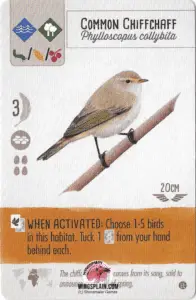
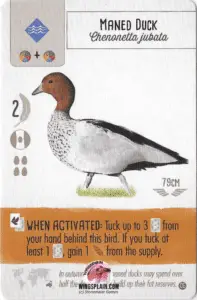
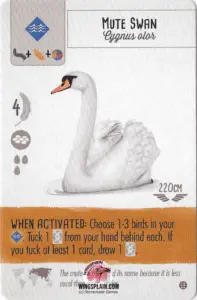
4. Play More Birds Per Turn
If managed properly, “Play Another Bird” cards break the action economy of the game in your favor by doubling your “Play A Bird” actions. These are resource-intensive actions, though, without that many discounts, they work best when other players are sharing resources.
Important combinations include Wingspan European Expansion’s teal-powered Yellowhammer, Moltoni’s Warbler, White Wagtail, and birds that cost zero food to play, such as “tuck to play” birds.
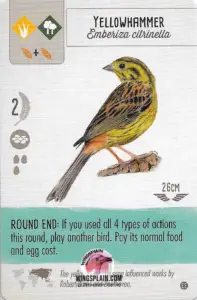
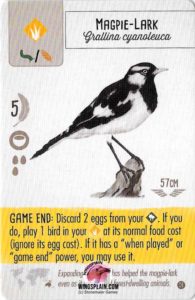
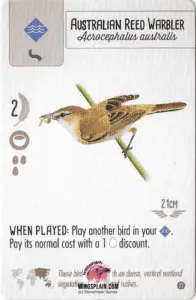
5. Acquire Bonus Cards Later in the Game
Bonus Card Birds tend to be better when played mid to late game, as you can cherry-pick bonus cards that score you points right now instead of trying to build into points from the start of the game and being at the mercy of the deck.
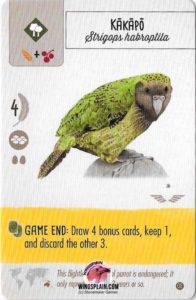
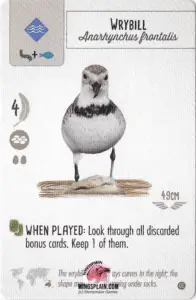
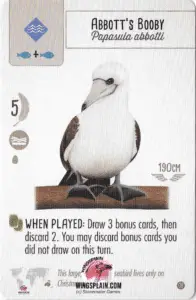
6. Take Advantage of Birds That Lay a Lot of Eggs in One Action
Don’t underestimate “Mass Egg Layers” (See Bobolink, Inca Dove). They can be huge point bombs at the end of the game if you’ve amassed the appropriate nest type.
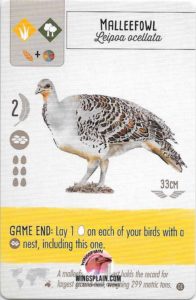
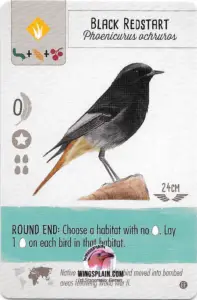
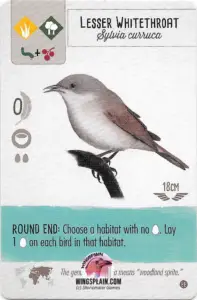
7. Play Birds in the Forest Habitat That Also Generate Points
In general, Forest engines tend to be weaker engines. Food isn’t inherently valuable and is only as good as the cards you have in hand.
If possible, add a couple of point-generating birds to your Forest engine. This will allow you to score points from the Gain Food Action and attempt to compete with Grasslands egg-laying and Wetlands tucking strategies.
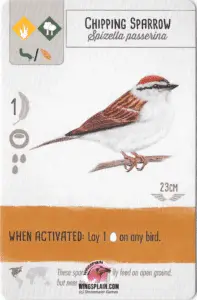
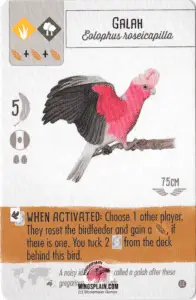
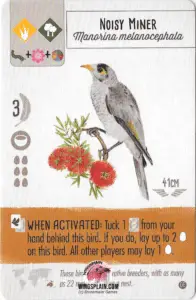
8. Cache/Discard food effectively
Caching or discarding food from your personal supply can sometimes be inefficient. This is because food in your personal supply can be multiplied into several victory points by playing more birds. Food is converted into victory points at a 1:1 ratio through caching effects or certain discard effects (such as House Sparrow’s power and the other European Expansion birds of this archetype).
Three food from your supply can be converted into three points through caching/discarding effects, or it can be multiplied into a maximum of nine points by playing a high-value bird. For more, read Hidden Value in Wingspan: Food Costs vs. Victory Points Scored
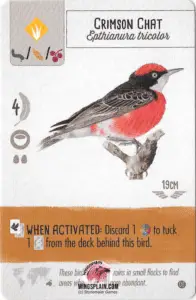
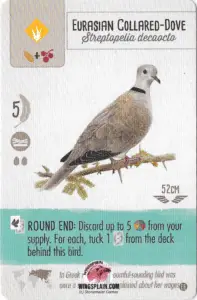
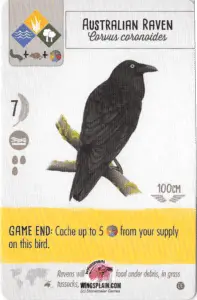
9. Don’t Overdraw Cards
Don’t go overboard with birds that draw cards without converting into points/resources unless they also bring other desirable qualities to the table, such as high point value (including qualification for bonus cards/round goals) and/or large egg capacity. Going all-in with a card drawing gambit.
A fist full of cards won’t do anything for you unless you happen to have Visionary Leader. Cards are not inherently valuable and are only as good as the food you have in your supply or the tucking powers you have at your disposal.
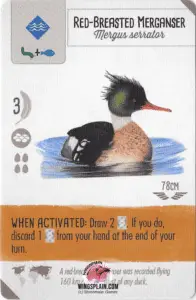
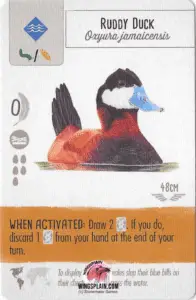
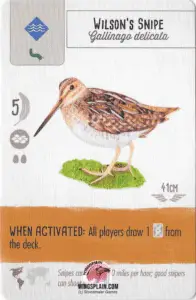
10. Choose Predator Cards Carefully
Predator Powers that involve “rolling dice outside the birdfeeder” to cache fish or rats are among the weakest point-scoring powers in the game. These powers are conditional and have a low success rate. This power is a coin flip at four dice (max possible).
Predator Powers that check the wingspan of the top card of the deck to tuck are among the weaker point-scoring powers in the game. Their abilities are conditional. Some have lower success rates than others. Currently, the best version of this power is “<100 CM,” which succeeds about 80% of the time.
If you end up with the right bonus cards, though, predator birds will make great point bombs, regardless of what their power does.
Giving resources to your opponents isn’t always bad. Make sure you are getting something in return that equals or exceeds the value you are giving out.
If you are not at least breaking even, do not give resources to your opponent. Strive to make sure that you are gaining a lot more out of the deal than your opponents are when possible. Appropriate Timing of Shared Resources
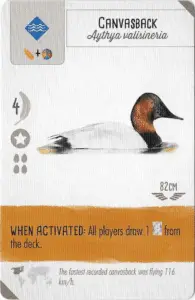
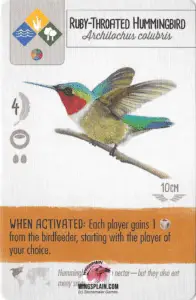

12. Favor Bird Cards That Accomplish Multiple Goals
When playing birds, favor ones that skew resource/action economy in your favor while also aligning with end-of-round goals and bonus cards as much as possible. This will result in optimized point-scoring and lead to victories/scores that sometimes take you by surprise. The Hidden Value in Wingspan: Food Costs vs. Victory Points Scored
13. Maximize Bonus Conversions, Especially with Nectar Use in the Oceania Expansion
Don’t forget about the bonus conversions on the player mats (trading cards for food, trading food for eggs, trading eggs or nectar for cards). Know how and when to use them to maximum effect.
Spending Nectar on these abilities is optimal as you can place it on the Spent Nectar spaces of the appropriate habitat. This is also an excellent way to spend nectar that would otherwise have to be discarded at the end of the round.
14. Use Nectar Effectively
Taking Nectar is not always the best play. Learn to make this distinction. The closer you get to the end of the round, the less beneficial it is to gain and hold nectar.
Don’t forget about bonus conversions (see Wingspan strategy tip 13 above). Additionally, you must discard nectar before activating end-of-game yellow powers, so you can’t stockpile it for point bombing once the game is over. Nectar can be spent on end-of-round teal powers. This can be some of the best use of nectar.
15. Know When to Let Good Cards Go
There are windows of opportunity for even the best cards. Many powers are at their peak at the beginning of the game and drop off substantially in effectiveness as you near the end. Brown and pink powers want to be played as early as possible, giving them the maximum activation opportunity.
16. Recognize Game-Breaking Bird Cards and How to Beat Them
Chihuahuan Raven and Common Raven break games.
Killdeer and Franklin’s Gull break games.
How to beat the best cards in Wingspan
Discover What Makes a Top Tier Card in Wingspan
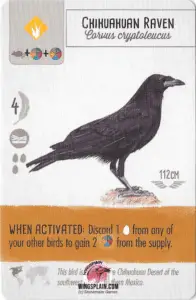
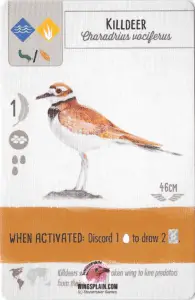
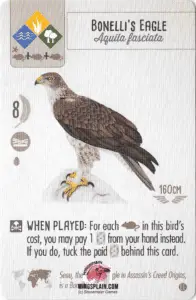
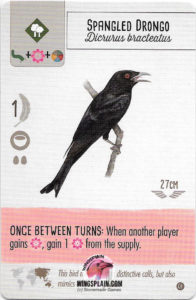

17. Understand Powerful Card Drawing Effects
Another great Wingspan strategy tip is to remember that in the early game and from the Wetlands, Common Yellow Throat, Rudy Duck, Pied Billed Grebe, Red Breasted Merganser, and Wood Duck skew card advantage heavily in your favor, especially on the Oceania Expansion mats. They give nothing to your opponents in exchange for this advantage.
The higher food costs of the Red-Breasted Merganser and Wood Duck are more easily mitigated if you are playing with nectar, as you get to start with one.
Audouin’s Gull grants card advantage and scores points even with an empty hand, no food in your supply, and it does not require interaction with opponents. No other tucking bird does this.

18. Use Effective Bird Card Combinations
Gala becomes even stronger when paired with Australian Zebra Finch or Eurasian Jay. Expanding the Power of Tucking Cards
Noisy Miner becomes even stronger when paired with Ravens/Killdeer/Franklin’s Gull. Watch your egg capacity. Top 5 OE Birds
Maned Duck plus “Wheat Eaters” break games (see Canada Goose and company). The Power of Tucking Cards, Expanding the Power of Tucking Cards
Great Blue Heron plus Great Egret plus Atlantic Puffin (or another big point bird) is a huge point bomb if you have the resources.
For more combos, see our article: 14 Powerful Card Combos in Wingspan
19. Establish Early Food and Card Generating Effects
If possible, at the start of the game, focus on establishing a reliable way of generating at least two food per Gain Food Action and drawing at least two cards per Draw Cards Action.
Establishing early game acceleration of this level allows you to compound your resources more effectively and efficiently than opponents who are stalling or aren’t as focused. Look no further than the Wingspan strategy tips in our Power 4 post to understand how effective this game state is.
20. Early and Continuous Activation of Average Powers is Better than Delayed Perfection
You only get 26 activations in each game. You need to make them count. If you hold out for a handful of “perfect plays,” you will be sacrificing precious time (action cubes).
In the absence of better options, combining several average powers early and activating them as much as possible will compound your points and resources to much higher volumes by the end of the game than a handful of power plays, more often than not.
21. Know How to End Your Game: Playing Birds vs. Egg Spam
Playing too many birds is a potential trap. This might seem counterintuitive in a game about playing birds, but this is another lesson in action efficiency. At the end of the game, you win by scoring the most points.
There comes a point in many games where Egg Spam is the optimal point-scoring strategy (although this happens less frequently with the Oceania Expansion). You need to identify the point at which you should transition from resource gathering and playing birds to instead running your engines repeatedly for the points they yield.
What are your favorite Wingspan strategy tips? Let us know in the comments!
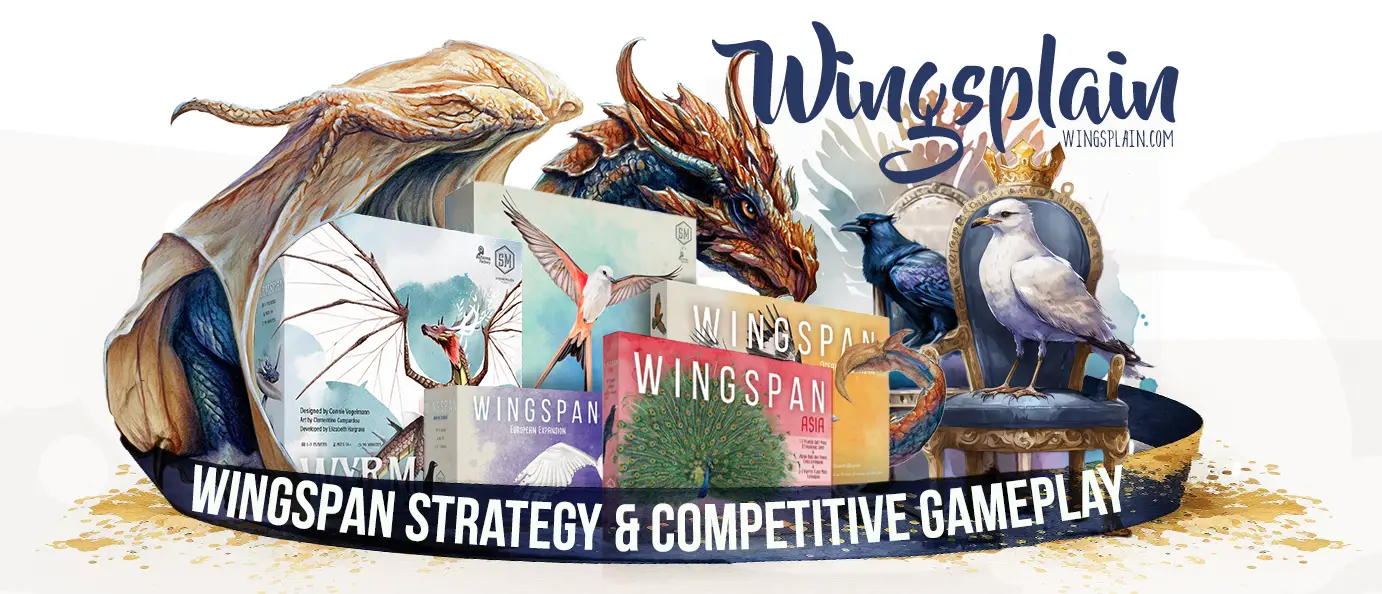
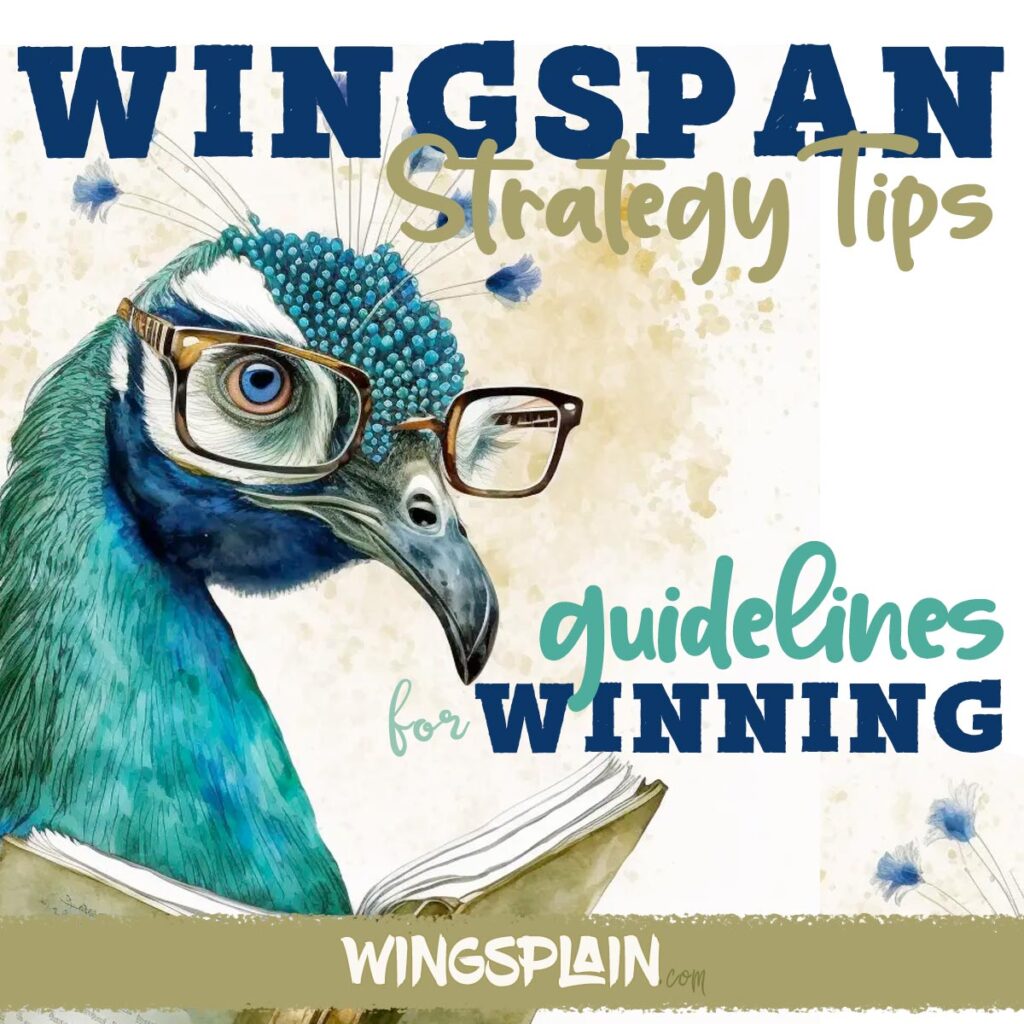
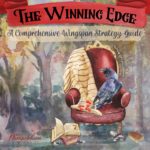
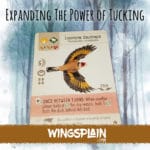
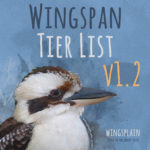
I’d love a blogpost detailing ideal management of the “Play Another Bird” cards–I always want to use these, but feel like my play ends up very clunky.
Hello, Jack. Great suggestion. I’ll have to add this to my to-do list.
Welcome to Wingsplain.
Half of these birds I’ve never seen on BGA, where are they from? Chiffchaff, Galah, Noisy Miner, and a lot of other I’ve never heard of.
Hello Michael,
The cards you haven’t seen on BGA are from Wingspan Expansions. The physical version of Wingspan currently has three expansions. The European, Oceania, and Asia expansions, with more on the way in the years ahead. You can find these expansions on the Stonemaier Games website HERE. This is the main Wingspan page with links to the expansions, which you can buy directly from Stonemaier. You can also sign up to be a Stonemaier Champion and receive a 20% discount on all purchases for a year. It’s a pretty great deal if you are going to buy multiple items at once.
BGA does not currently have Wingspan expansions and, to the best of my understanding, there are currently no plans for them to become available there. It’s a bit of a long story but the short version is that Monster Couch produces the digital adaptation of Wingspan and also produces the expansions. Oceania just became available so make sure you check that out if you want to play online. Since Monster Couch previously had the rights to produce the digital version of Wingspan, they had to sign off on the core game going to BGA, which I believe was coordinated by Stonemaier Games. That’s pretty much the jist of it.
Great tips! I really liked the advice about managing bird cards—it’s already made a big difference in how I play. I’m excited to try out some of these strategies at my next game night!
Great tips! I particularly appreciate the emphasis on balancing your bird powers with resources. I’ve been struggling with that in my games. Looking forward to trying out some of these strategies next time I play!
Great tips! I particularly love the emphasis on balancing food and card acquisition early in the game. It has made a huge difference in my strategy. Can’t wait to try some of the other suggestions in my next game!
Great tips! I especially appreciate the focus on engine building and how crucial it is to plan ahead. Can’t wait to try out some of these strategies in my next game!